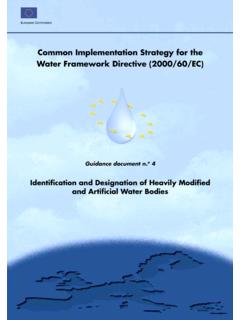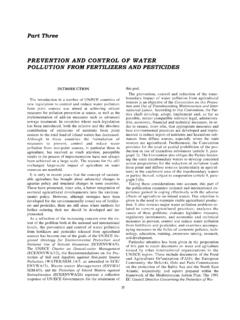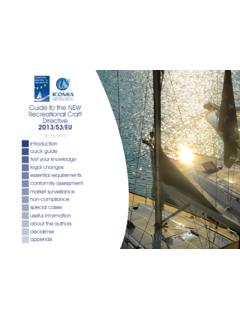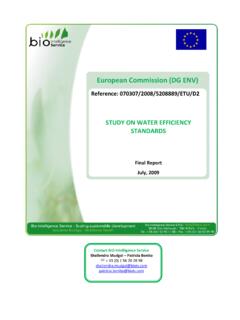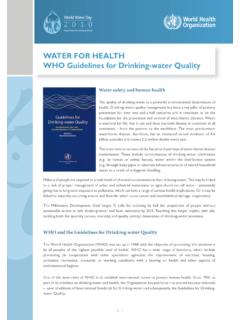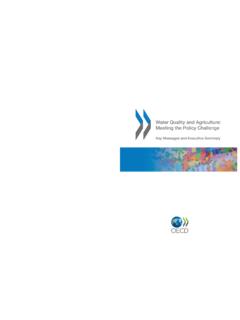Transcription of BY ORDER OF THE AIR FORCE POLICY DIRECTIVE …
1 BY ORDER OF THE AIR FORCE POLICY DIRECTIVE 90-17. SECRETARY OF THE AIR FORCE . 18 NOVEMBER 2016. Special Management ENERGY AND water MANAGEMENT. COMPLIANCE WITH THIS PUBLICATION IS MANDATORY. ACCESSIBILITY: Publications and forms are available for downloading or ordering on the e-Publishing web site at RELEASABILITY: There are no releasability restrictions on this publication. OPR: SAF/IEN Certified by: SAF/IE. (Ms. Miranda Ballentine). Supersedes: AFPD90-17, 29 November 2011 Pages: 10. This DIRECTIVE establishes the framework for energy management within the Air FORCE ; the Air FORCE energy management program addresses the use, conservation, and security of energy and water across all Air FORCE missions.
2 It implements Department of Defense (DoD) DIRECTIVE (DoDD) , Energy POLICY ; DoDD , Assistant Secretary of Defense for Operational Energy Plans and Programs; and DoD Instruction (DoDI) , Installation Energy Management. Air FORCE POLICY DIRECTIVE (AFPD) 90-17 also interfaces with POLICY and responsibilities found in AFPD 23-2, Management of US Air FORCE Bulk Petroleum and Related Products; and DoDI , DoD Management POLICY for Energy Commodities and Related Services, as they relate to energy management. This AFPD applies to all military and civilian Air FORCE personnel, including all Air FORCE Reserve units and the Air National Guard (ANG). This publication will be applied to contractors or other persons through the contract or other legally binding agreement with the Department of the Air FORCE .
3 Ensure that all records created as a result of processes prescribed in this publication are maintained in accordance with (IAW) Air FORCE Manual (AFMAN) 33-363, Management of Records, and disposed of IAW the Air FORCE Records Disposition Schedule (RDS) in the Air FORCE Records Information Management System (AFRIMS). The use of the name or mark of any specific manufacturer, commercial product, commodity, or service in this publication does not imply endorsement by the Air FORCE . Refer recommended changes and questions about this publication to the Office of Primary Responsibility (OPR) using the Air FORCE (AF) Form 847, Recommendation for Change of Publication; route AF Forms 847 from the field through the appropriate functional chain of command.
4 See Attachment 1 for a glossary of references and supporting information. 2 AFPD90-17 18 NOVEMBER 2016. SUMMARY OF CHANGES. This document incorporates new DoD policies identified in DoDD ; removes references to cancelled issuances, including DoDI , Energy Management POLICY ; and realigns responsibilities IAW with the 2014 Air FORCE reorganization. 1. Overview: This POLICY DIRECTIVE : Establishes POLICY and assigns responsibilities for management of the Air FORCE energy program. Addresses activities and processes throughout the Air FORCE that require energy. This includes: infrastructure, aviation, ground vehicle and equipment operations, as well as science and technology initiatives with potential energy impacts.
5 These activities and processes can occur at enduring and non-enduring locations. Institutes the overarching approach that energy projects should enhance mission assurance through energy assurance, with a focus on improving resiliency, promoting cost- competitiveness, and being cleaner than alternatives. 2. POLICY . The Air FORCE will: Comply with all higher-level energy-related laws and policies, to include Executive Orders and Office of the Secretary of Defense (OSD) directives and instructions, as appropriate and without impacting mission execution. Implement DoD energy strategies, policies, and operational energy certification requirements, and budget for energy programs and projects consistent with DoD and Air FORCE requirements and priorities.
6 Utilize accepted voluntary consensus and industry standards related to energy and water , unless the standard would result in a potential negative mission impact. Develop and maintain an overall approach to energy management that identifies, plans, and implements improvements in the way the Air FORCE uses energy within every Air FORCE functional area. Consider energy security improvements, efficiencies, and capabilities as a factor in requirements identification and budget development, and provide favorable consideration to projects that improve energy resilience for assets critical to mission accomplishment. Be able to power any infrastructure identified as critical to the performance of mission essential functions independent of the utility grid for the period of time needed to relocate the mission or for at least seven days, whichever is longer.
7 Maximize the use of energy efficient technologies and processes within Air FORCE mission, technical, and financial constraints. Balance the objectives of Air FORCE energy projects to optimize cost and provide resilient, cleaner sources of energy to enhance mission assurance through energy assurance, with an increased focus on meeting multiple objectives within single projects. AFPD90-17 18 NOVEMBER 2016 3. Improve the energy performance of weapons systems, platforms, equipment, and products; installations, to include both enduring and non-enduring locations; and military forces consistent with statutory, Executive ORDER , DoD, and Air FORCE requirements. Develop and acquire equipment and technologies through the research and development processes that improve energy performance or increase energy security.
8 Install and use enterprise-wide energy data collection and management systems on Air FORCE installations to facilitate efforts to reduce energy consumption, improve operations, and achieve greater energy effectiveness through energy consumption management. When implementing based on these parameters, the data collection and management system must be approved and managed as a network service IAW AFI 33-115, Air FORCE Information Technology (IT) Service Management. Diversify energy supplies and sources, including renewable energy sources and alternative fuels, across the aviation, facility, and ground vehicle/equipment domains. Leverage alternative financing mechanisms, to include performance contracting tools, to acquire renewable energy and fund energy efficiency projects whenever practical.
9 Pursue such projects that provide the Air FORCE with an acceptable rate of return, improve energy performance, and/or contribute to increased energy security and resiliency for critical missions. Ensure any alternative fuels acquired for operational purposes are life-cycle cost- competitive with traditional fuels and qualified as compatible with existing equipment and infrastructure. Integrate energy considerations, as appropriate, into all levels of requirements generation: the Strategy, Planning, and Programming Process (SP3) process; acquisition;. training; and all phases of operations to ensure energy is recognized as a mission critical need and that improvements in energy performance can help increase combat capabilities, optimize operations, and improve efficiencies for both installations and weapon systems.
10 Support the use of energy analyses in Air FORCE requirements, acquisition, and SP3. processes, including the use of the fully burdened cost of energy and the Energy Key Performance Parameter (eKPP). Incorporate energy demand and logistics supportability into exercises and wargames. View energy resources and requirements as central to combat mission readiness and critical to providing a strategic advantage. 3. Roles and Responsibilities. This DIRECTIVE establishes the following roles and responsibilities: The Secretary of the Air FORCE (SecAF) retains ultimate responsibility for all policies related to the Department of the Air FORCE . The Assistant Secretary of the Air FORCE for Installations, Environment and Energy (SAF/IE) serves as SecAF's agent within the energy domain, including as the Air FORCE Senior Energy Official, which focuses on installation energy, and the Senior Operational Energy Official, which focuses on operational energy IAW Headquarters Air FORCE (HAF).










